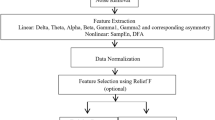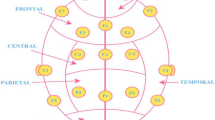Abstract
Depression or Major Depressive Disorder (MDD) is a mental illness which negatively affects how a person thinks, acts or feels. MDD has become a major disease affecting millions of people presently. The diagnosis of depression is questionnaire based and is not based on any objective criteria. In this paper, feature extracted from EEG signal are used for the diagnosis of depression. Alpha, alpha1, alpha2, beta, delta and theta power and theta asymmetry was used as feature. Alpha1, alpha2 along with theta asymmetry was also used as a feature. Multi-Cluster Feature Selection (MCFS) was used for feature selection when feature combination was used. The classifiers used were Support Vector Machine (SVM), Logistic Regression (LR), Naïve-Bayesian (NB) and Decision Tree (DT). Alpha2 showed higher classification accuracy than alpha1 and alpha power in all applied classifier. From t-test it was found that there was a significant difference in the theta power of left and right hemisphere of normal subjects, but there was no significant difference in depression patients. Average theta asymmetry in normal subjects is higher than MDD patients but the difference in theta asymmetry in normal subjects and MDD patients is not significant. The combination of alpha2 and theta asymmetry showed the highest classification accuracy of 88.33% in SVM.



Similar content being viewed by others
References
American Psychiatric Association (2013) Diagnostic and statistical manual of mental disorders. 5th edition. American Psychiatric Association Washington, DC.
World Health Organization, Depression and other common mental disorders Global Health estimates. Geneva: WHO Document Production Services, 2017.
Mahato, S., and Paul, S., Electroencephalogram (EEG) signal analysis for diagnosis of major depressive disorder (MDD): A review. In: Nath, V., Mandal, J. K. (Eds), Nanoelectronics, circuits and communication systems (NCCS 2017). Singapore: Springer, 2017, 323–336.
Hosseinifard, B., Moradi, M. H., Rostami, R., Classifying depression patients and Normal subjects using machine learning techniques. In: 19th Iranian conference on electrical engineering, Tehran, Iran, pp 339–345, (2011).
Cai, H., Han, J., Chen, Y., Sha, X., Wang, Z., et al. A pervasive approach to EEG-based depression detection. In: Hindawi, pp 1–13, (2018).
Niemiec, A. J., Lithgow, B. J. Alpha-band characteristics in EEG spectrum indicate reliability of frontal brain asymmetry measures in diagnosis of depression. In: IEEE engineering in medicine and biology 27th annual conference, Shanghai, China, pp 7517–7520, (2005).
Kan, D. P. X., Lee, P. F., Decrease alpha waves in depression: An electroencephalogram (EEG) study. In: International conference on BioSignal analysis, processing and systems (ICBAPS), pp 155-161, (2015).
Stewart, J. L., Coan, J. A., Towers, D. N., Allen, J. J., Resting and task-elicited prefrontal EEG alpha asymmetry in depression: Support for the capability model. In: Psychophysiology, pp 1–18, (2014).
Mumtaz, W., Xia, L., Ali, S. S. A., Yasin, M. A. M., Ali, S. S. A., Malik, A. S., A wavelet-based technique to predict treatment outcome for major depressive disorder. In: PLOS ONE, pp 1–30, (2017).
American Psychiatric Association (1994) Diagnostic and statistical manual of mental disorders. 4th edition. American Psychiatric Association Washington, DC, pp 339–345
Teplan, M., Fundamental of EEG measurement. In: Measurement Science Review, Vol 2, pp 1–11, (2002).
Dien, J., Issues in the application of the average reference: Review, critiques and recommendations. In: Behavior Research Methods Instruments & Computers, pp 34–43, (1998).
Gandhi, V., Brain computer interfacing for assistive robotics. Electroencephalograms, recurrent quantum neural networks, and user-centric graphical interfaces, 1st edition, academic press, pp 21-29, (2014).
Delorme, A., Makeig, S., EEGLAB: An open source toolbox for analysis of single-trial EEG dynamics including independent component analysis. In: Journal of Neuroscience Methods, pp 9–21, (2004).
Alelyani, S., Tang, J., Liu, H., Feature selection for clustering: A review.In: Reddy CK, Agarwal CC, data clustering: Algorithms and applications pp 1-12, (2013).
Mahato, S., Roy, A., Verma, A., Paul, S., Analysis of feature selection and reduction techniques for detection of depression using EEG signals. International conference on computational intelligence and data analytics (ICCIDA-2018), Bhubaneswar, (2018).
Roffo, G., Melzi, S., Ranking to learn: Feature ranking and selection via eigenvector centrality. In: Lecture Notes in Computer Science, pp 19–35, (2017).
Cai, D., Zhang, C., He, X., Unsupervised feature selection for multi-cluster data. In KDD, pp 333-342, (2010).
Roffo, G., Melzi, S., Castellani, U., Infinite latent feature selection: A probabilistic latent graph-based ranking approach. IEEE international conference on computer vision (ICCV 2017), Venice, (2017).
Belkin, M., Niyogi, P., Laplacian Eigen maps and spectral techniques for embedding and clustering. In: Advances in Neural Information Processing Systems, pp 585–591, (2001).
Hastie, T., Tibshirani, R., Friedman, J., The elements of statistical learning. In: Data Mining, Inference, and Prediction, Springer-Verlag, New York, (2001).
Efron, B., Hastie, T., Johnstone, I., Tibshirani, R., Least angle regression. In: Annals of Statistics, pp 407–499, (2004).
Han, J., Kamber, K., Pei, J., Data mining: Concepts and techniques. Morgan Kaufmann, Elsevier, USA, 3rd edition, pp 327-413, (2012).
Vapnik, V., Cortes, C., Support-vector networks. In: Machine Learning, pp 273–297, (1995).
Kutner, M. H., Nachtsheim, C. J., Neter, J., Applied linear statistical models, 5th edition, McGraw-hill, New York.Pp 555-603, (2005).
Mumtaz, W., Xia, L., Ali, S. S. A., Yasin, M. M. A. M., Hussain, M., Malik, A. S., Electroencephalogram (EEG)-based computer-aided technique to diagnose major depressive disorder (MDD). In: Biomedical Signal Processing and Control, Volume 31, January 2017, pp 108–115, (2017).
Grin-Yatsenko, V. A., Baas, I., Ponomarev, V. A., Kropotov, J. D., Independent component approach to the analysis of EEG recordings at early stages of depressive disorders. In: Clinical Neurophysiology, Vol. 121, 2010, pp 281–289, (2010).
Mahato, S., Paul, S., Detection of major depressive disorder using linear and non-linear features from EEG signals. In: Microsystem Technologies, Springer, 2018, pp 1–12, (2018).
Gollan, J. K., Hoxha, D., Chihade, D., Pflieger, M. E., Rosebrock, L., Cacioppo, J., Frontal alpha EEG asymmetry before and after behavioral activation treatment for depression. In: Biol Psychol, pp 1–28, (2014).
Acknowledgments
The authors would like to thank Mumtaz et al. [9] for the dataset contribution.
Author information
Authors and Affiliations
Corresponding author
Ethics declarations
Conflict of Interest
The authors declare that they have no conflict of interest.
Ethical Approval
This article does not contain any studies with human participants or animals performed by any of the authors.
The dataset used in this study is described in the paper by Mumtaz et al. and is publically available dataset (https://figshare.com/articles/EEG-based_Diagnosis_and_Treatment_Outcome_Prediction_for_Major_Depressive_Disorder/338516) [9]. According to the contributors of the dataset [9], all procedures performed in studies involving human participants were in accordance with the ethical standards of the institutional and/or national research committee and with the 1964 Helsinki declaration and its later amendments or comparable ethical standards.
Informed Consent
According to the contributors of the dataset [9], informed consent was obtained from all individual participants included in the study.
Additional information
Publisher’s Note
Springer Nature remains neutral with regard to jurisdictional claims in published maps and institutional affiliations.
This article is part of the Topical Collection on Systems-Level Quality Improvement
Rights and permissions
About this article
Cite this article
Mahato, S., Paul, S. Classification of Depression Patients and Normal Subjects Based on Electroencephalogram (EEG) Signal Using Alpha Power and Theta Asymmetry. J Med Syst 44, 28 (2020). https://doi.org/10.1007/s10916-019-1486-z
Received:
Accepted:
Published:
DOI: https://doi.org/10.1007/s10916-019-1486-z




